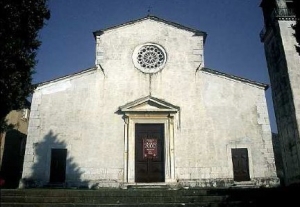
Information
Foundation:
XII century
District/Location:
Pietrasanta, Vallecchia
District:
Versilia


First documented in the 12th century, few traces remain of the original building after numerous subsequent, at times illicit alterations. The interior includes some 14th century frescoes attributed to the same artist whose work is also found in the nearby Parish Church of Saints Giovanni and Felicita in Valdicastello.
Pietrasanta, Vallecchia
The earliest reference to the community of "Vallecule" dates to 843, but the first documentation of a church in this location is from 1097.
A Chapel of Vallecchia is recorded in the 12th century next to the Church of S. Stefano in Corvaia. According to some scholars the Church of Vallecchia took over the role of Parish Church from that of Corvaia in the first half of the 13th century, when the overlooking fortresses underwent repeated attack (being the head quarters of the extremely powerful aristocratic family of the same name, that contested control of the area with the rising Town Council of Lucca). This probably led to the destruction of both the old Parish Church of Corvaia and the other Church of S. Andrea, consecrated by the Bishop in 1160 and recorded in the "Decime bonifaciane" (1296-97) as "chapel Burgi".
At one time the Parish Church of Vallecchia headed the churches of Seravezza, La Cappella, Terrinca, Ruosina, Basati, Levigliani and later Querceta. But from the 16th century it lost this role to the Church of Seravezza, that first obtained the right to the christening font (1531) and was then definitively detached in 1670.
Vallecchia was the most peripheral of the parish churches within the diocese of Luni, where it remained even after the diocese was fragmented into those of Sarzana - La Spezia and Massa – and Pontremoli. Only in 1798, when the area was again rearranged, did it became part of the diocese of Pisa, along with the rest of the Medicea Versilia, where it remains to this day. Of the original building only the plan and apse remain. All other traces have been cancelled by the subsequent, at times illicit alterations.
In the apsidal basin, there are some late 14th century frescoes attributable to the author of a work with a similar subject – Christ in Judgement with the Virgin Mary and San Giovanni and the Evangelical Tetramorph – in the Parish Church of Saints Giovanni and Felicita of Valdicastello.
The fragment of an altar-piece with Saints Sebastiano Rocco and Antonio and a Eucharistic shrine date to a 16th century refurbishment. The marble pulpit by Andrea Baratta from Carrara, dates to the 18th century.
A Chapel of Vallecchia is recorded in the 12th century next to the Church of S. Stefano in Corvaia. According to some scholars the Church of Vallecchia took over the role of Parish Church from that of Corvaia in the first half of the 13th century, when the overlooking fortresses underwent repeated attack (being the head quarters of the extremely powerful aristocratic family of the same name, that contested control of the area with the rising Town Council of Lucca). This probably led to the destruction of both the old Parish Church of Corvaia and the other Church of S. Andrea, consecrated by the Bishop in 1160 and recorded in the "Decime bonifaciane" (1296-97) as "chapel Burgi".
At one time the Parish Church of Vallecchia headed the churches of Seravezza, La Cappella, Terrinca, Ruosina, Basati, Levigliani and later Querceta. But from the 16th century it lost this role to the Church of Seravezza, that first obtained the right to the christening font (1531) and was then definitively detached in 1670.
Vallecchia was the most peripheral of the parish churches within the diocese of Luni, where it remained even after the diocese was fragmented into those of Sarzana - La Spezia and Massa – and Pontremoli. Only in 1798, when the area was again rearranged, did it became part of the diocese of Pisa, along with the rest of the Medicea Versilia, where it remains to this day. Of the original building only the plan and apse remain. All other traces have been cancelled by the subsequent, at times illicit alterations.
In the apsidal basin, there are some late 14th century frescoes attributable to the author of a work with a similar subject – Christ in Judgement with the Virgin Mary and San Giovanni and the Evangelical Tetramorph – in the Parish Church of Saints Giovanni and Felicita of Valdicastello.
The fragment of an altar-piece with Saints Sebastiano Rocco and Antonio and a Eucharistic shrine date to a 16th century refurbishment. The marble pulpit by Andrea Baratta from Carrara, dates to the 18th century.
Scopri altre attrazioni vicino a Saint Stephen Protomartyr
See allYou may also like..
See allFind more
0











